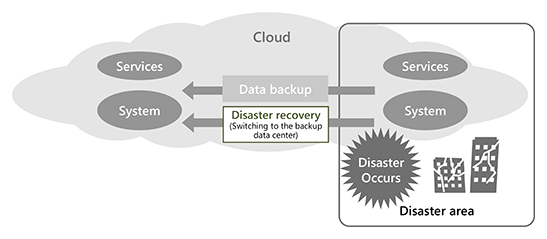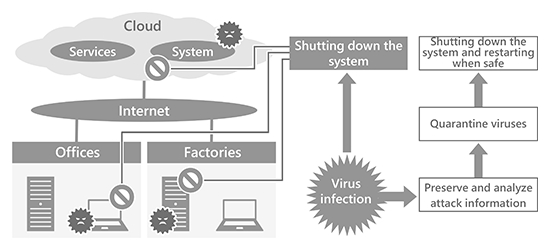Governance and Resources
We are working to strengthen IT governance to ensure information security, IT compliance, and business continuity across the entire Hitachi Group.
In addition, we are accelerating the reallocation of IT resources, training, and the securing of diverse talent, and advancing the globalization of IT talent.
IT-BCP#1: Supporting Business Continuity through IT
With respect to large-scale earthquakes (such an earthquake is said to have a high probability of occurring in Japan in the near future) and natural disasters arising from global warming, as well as various other kinds of emergencies, such as pandemics and cyberattacks, we are formulating and operating IT-BCPs that enable us to support business continuity for the Hitachi Group through IT.
In addition, we are continually revising our plans so that we will be able to support the latest IT architecture.
Responding to disasters
In preparation for large-scale disasters, we select cloud services that can enable us to continuously provide services if a disaster occurs. Also, we have set recovery time objectives for each service and defined disaster prevention levels accordingly. In addition, we have established secondary servers and data backup environments to ensure data preservation, while also implementing a system that enables early disaster recovery by deploying systems for services critical to business continuity across multiple cloud regions. Also, to prepare for emergency situations, we regularly conduct training in line with the BCP (Business Continuity Plan).
In response to new work styles and the expansion of cloud usage, we established and improved our remote work environment. By using the remote work environment, we are able to continue our business even in the event of a pandemic. In addition, we defined priorities for necessary system operations according to the degree of impact on the social function maintenance business and created operation plans.

Responding to cyberattacks
To address cyberattacks, we are implementing robust security measures by transitioning to an architecture based on zero-trust security. In anticipation of cyberattacks such as ransomware, targeted email attacks, worm-type viruses, and unauthorized access to servers open to the public, we have prepared response methods, from initial action to recovery, that are tailored to each type of attack. For example, these methods include isolating infected systems by shutting down the systems and suppressing the startup of applications, preserving and analyzing attack information, quarantining viruses, and shutting down the systems and restarting them when safe. We are working hard to ensure safe system operation and rapid recovery.
Furthermore, to firmly establish and improve our BCP, we regularly review our measures, for example, by conducting training aligned with anticipated cyberattacks and the latest IT architecture, and by preparing for new threats.

#1 BCP: Business Continuity Plan





